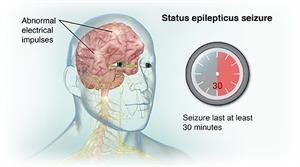Which of the Following Best Describes Status Epilepticus
D It is a medical emergency. Definitions Seizure1 Finite episodes of disturbed cerebral function Status Epilepticus.

Status Epilepticus Johns Hopkins Medicine
Refractory and Super Refractory Status Epilepticus - Presenters.

. Status epilepticus SE is a very severe type of seizure. Status epilepticus SE is a common life-threatening neurologic disorder that is essentially an acute prolonged epileptic crisis see the image below. Benzodiazepines are the most effective drugs for treating status epilepticus.
Hirsch MD FAAN FACNS FANA FAES. Two or more seizures with tonic-clonic activity without an intervening period of consciousness You respond to a 32-year-old female who is having a seizure. Which of the following best describes you.
Absence complex partial simple. For someone who has seizures theyre normally similar in length each time they occur and typically stop once that time period has passed. A A seizure involving convulsions on only one side of the body b Two or more seizures with tonic-clonic activity without an intervening period of consciousness c A period of drowsiness following tonic-clonic seizures d A seizure that occurs without a known cause.
This algorithm describes the approach to a convulsive generalized seizure lasting 5 minutes. Which of the following BEST describes status epilepticus. 1continuous clinical andor electrographic seizure activity or 2.
Ochsner is a 501c3 not-for-profit organization founded on providing the best patient care research and education. It redistributes to the entire brain in 15 minutes from the point of injection even though it has high lipid solubility. Types of generalized seizures include tonic-clonic and.
Out of all the three drugs diazepam is the first in line for managing status epilepticus. A It is a state of prolonged continuous seizure activity. RationaleStatus epilepticus is a neurologic life-threatening emergency characterized by prolonged or clustered seizures in which consciousness does not return between seizures.
Get medical help right away if you have a convulsive seizure that lasts more than 5 minutes. Airway breathing and circulation. Which of the following best describes the main advantage of the fosphenytoin over phenytoin itself.
SE is defined as a continuous seizure lasting more than 30 min or two or more seizures without full recovery of consciousness between any of them. For a patient with recurrent seizures who isnt actively seizing a more gradual approach may be taken with escalation if an active seizure re-emerges. Founded on providing the best patient care research and education.
A patient with status epilepticus has received an IV dose of lorazepam. Within the following pages you will find our Exhibitor Prospectus which describes. Recurrent seizure activity without recovery returning to baseline between seizures.
Incorporation of safe and ethical practices. At the institution at which you trained phenytoin would be given next but the attending orders fosphenytoin. SE can represent an exacerbation of a preexisting seizure disorder or the initial manifestation of a seizure disorder epilepsy or it can represent an insult other than a seizure disorder.
Status epilepticus is a neurological emergency requiring immediate evaluation and management to prevent significant morbidity or mortality. Operational Definition Status Epilepticus is defined as 5 minutes or more of. Which one of the following is not used in status epilepticus.
Convulsive status epilepticus is a medical emergency. Which of the following BEST describes status epilepticus. Status epilepticus SE is a medical emergency associated with significant morbidity and mortality.
The duration of time in which a patient can be in convulsive status epilepticus before brain damage occurs is unknown. Administration of anticonvulsants to cease seizure activity is key along with management of basic life support. Historical definition12 30 minutes of continuous seizure activity H2 seizures without full recovery of consciousness between the seizures.
Which of the following best describes you. The incidence of status epilepticus was bimodally distributed occurring most frequently during the first year of life and after the age of 60 years1 2 Among adults patients older than 60 had. We are pleased to announce the 2022 workshop Management of Refractory and Super Refractory Status Epilepticus for Neurologists and Intensivists and hope you mark your calendar with the date and plan to be a part of this upcoming ACCME accredited program.
Previously status epilepticus was defined as a seizure with a duration equal to or greater than 30 minutes or a series of seizures in which the patient does not regain normal mental status between seizures. EEG Patterns Guiding the Management of Refractory and Super-refractory Status Epilepticus in Adults Lawrence J. The commonly used drugs are lorazepam midazolam and diazepam.
Establish best practices in the use of EEG data and brain imaging findings to guide medical decisions. B It consists of frequently repeated seizures without the patient regaining consciousness. The recurrence of unprovoked seizures characterized by sudden attacks of altered consciousness motor activity or sensory impairment is called.
Establish best practices for the selection of therapeutic options in the management of Refractory and Super Refractory Status Epilepticus to achieve optimal outcomes. C It is an irreversible progressive disease that leads to dementia. Dropsy epilepsy status epilepticus seizure disorder.

Understanding Epilepsy Chart 20x26 Epilepsy Epilepsy Facts Epilepsy Awareness

Pin By Cassie Abendroth On Nursy Stuff Nursing Notes Nursing Students Nurse
No comments for "Which of the Following Best Describes Status Epilepticus"
Post a Comment